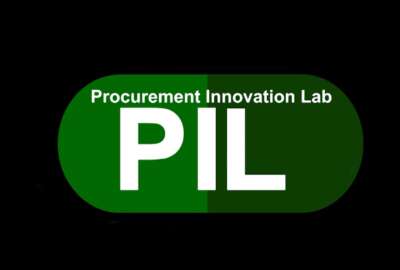

Scott Simpson, the digital transformation lead for the Procurement Innovation Lab at the Homeland Security Department, said it’s planning a “hack the policy”...
The Procurement Innovation Lab at the Department of Homeland Security is entering phase three of its lifecycle.
This is where the PIL takes everything it has learned over the last several years about changing the culture of procurement and begin applying it at deeper, programmatic level.
Scott Simpson, the digital transformation lead for the Procurement Innovation Lab at DHS, said the next chapter is all about improving the “big A” acquisition process.

“We’re looking at how do we take everything we’ve learned from changing the culture of procurement, start applying it to changing the culture of mission?” Simpson said in an interview with Federal News Network. “It’s going to be a lot of different things in phase three. From using the relationship that we built in phase two at the procurement level to now changing those relationships to expand outwards and look at the broader picture and say, ‘Hey, you were an awesome partner with us as we focused on this small ‘A’ procurement so now help me take that and broaden it to this whole big program, this big ‘A’ acquisition there.’”
While details around some of the specific initiatives and projects the PIL will launch are still coming together, Simpson said the team likely will start internally to work with DHS and components acquisition offices before moving to non-DHS agencies.
“We’re starting with in-house projects. What are some of our policies that are getting in the way of our acquisition workforce? What are some of the bigger things that are that tripping people up that we can work on together to find a common solution?” he said. “In fiscal 2022, we deployed the PIL idea competition, and one of the first PIL idea competitions was sponsored by our policy office. We have the Appendix G process, which looks at security, and it was a real process to go through Appendix G. So we got all this feedback about how can we streamline this process, and that’s what really helped us start thinking about the bigger picture.”
One way the PIL will reimagine acquisition policies is through a “hack the policy” type of competition. The Army Contracting Command at Aberdeen Proving Ground did something similar in 2022, eventually removing 60 pages and three months of required reviews from its internal acquisition policy guidance.
Simpson said the goal is to bring all the interested parties together — the contracting officers, the policy owners, the lawyers and anyone else — to address challenges by reworking and improving DHS’s guidance.
“I think the big obstacle is unlearning. Actually, there’s this concept of being an infinite learner and it’s really hard to be an infinite learner. But being an infinite learner means having the ability to learn something, unlearn that and learn the next thing. For so long, and in our work series, we were not infinite learners. We are focused on what it says in the FAR and then once you learn that, you can apply it forever,” he said. “So it’s unlearning the learning process that we had in place. Part of it is learning that I have permission to do that, and I’m not going to get in trouble if I take the leap. We’re trying to instill upon the workforce that courage to go and take the leap as the permission to innovate and the ability then to reengage their critical thinking, which for so long has been pushed back on when you say, ‘Hey, I’ve got this new idea,’ and someone says, ‘No, that’s not how we’ve done it before. Let’s just do it that way because we know we didn’t get a protest or whatever else.’”
Simpson said the PIL would take those internal experiences and lessons learned and share them with other agencies. He said the “train-the-trainer” model continues to work well for the PIL.
Since the PIL’s creation in 2015, one of its main goals has been to spread the culture of innovation not just throughout DHS, but across all agencies.
Simpson said in 2023, the PIL trained over 1,600 people in just its coaching clinic, which is for individuals who want to start to coach teams and do things like the PIL and help mentor and support others to use innovations within their own organizations.
“We’re working with our Homeland Security Acquisition Institute to find the right learning module to keep pushing forward in the learning environment [that fits the person the best]. What does that look like? What is the content like because one of the things we’re really heavy into is we don’t want someone just sitting there listening or watching slides and click, click, click, and we want it to be engaging. We know that adult learners learn by doing, and so we want to keep engaging them throughout the class, via whatever new methodologies they have, whether it’s scenario-based learning, reactive learning, going out and doing it learning and coming back,” he said. “We’re working with our Homeland Security Acquisition Institute to figure out what is that right first step. We’re hoping in the next half of the year we will push out at least one module. Once we get that one module done, then we’ve learned how to do it for other modules and we can start building a whole series of innovation modules.”
He added some of the ideas for that first module is around facilitating evaluations of different procurement strategies for different types of acquisitions through multiple award contracts as well as open market solicitations.
The PIL will pilot the modules, take the feedback from that initial set of students and iterate with a goal of eventually making it available for all agencies.
Another priority area for the PIL this year is emerging technology. One of its action groups is analyzing how tools like robotics process automation and artificial intelligence can help address the rote and mundane things that contracting officers have to do.
“How can you take emerging technologies and start to apply it so that you look at not just this action that they do, but the one before and the one after it? How do you put it all together?” Simpson said. “We’ve got this action group that’s looking at that and starting to implement things for closeouts or for responsibility delegations. It’s these little things that the acquisition workforce knows that it’s just something that they’ve got to do today and, oftentimes, they put it off because it’s time-consuming or mundane. But it’s also really important because it helps us to balance our books and it brings back money that actually can be spent on other things. There’s so many reasons why they need to do this. So we’re trying to help both sides understand the perspective and do something with emerging technology to help people out.”
Copyright © 2025 Federal News Network. All rights reserved. This website is not intended for users located within the European Economic Area.
Jason Miller is executive editor of Federal News Network and directs news coverage on the people, policy and programs of the federal government.
Follow @jmillerWFED


